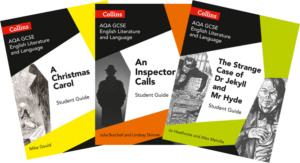This interactive drama lesson has been designed to support your teaching of A Christmas Carol.
‘Roll up, roll up, Ladies and Gentleman! Spend your coppers on my wares, for who wouldn’t want the gift of kindness for Christmas? Not you, Sir? Hang on, hang on, what about the chance for a new beginning? Or for you madam, a new shawl from my lovely vendor over here? Made by hand by children those were, their little fingers are best to get the lace just right.’
Imagine your classroom, or better still, the Drama studio, alive with the bustle of a Christmas market, an authentic Victorian market with props and researched in a way that enables students to achieve A01, A02, A03 whilst enjoying themselves. Here’s how:
A few lessons before the market begins you will need to set the scene. Depending on the size of your class you can choose the following characters to tend their stalls: A child street seller, a rich cotton merchant, Tiny Tim, early Scrooge and later Scrooge and the Ghosts of Christmas past and present. Alternatively, let students choose their own characters from the text. You will also need students to be Victorian poor and Victorian rich members of the public.
For props I suggest tables, Victorian outfits – rags, top hats, canes, and shawls, sheets for the ghosts, chocolate coins for the customers, making sure you give less to the poor by taking your influence from Scrooge and information sheets made by students. Playing music of the era would be fantastic too.
Objectives
The objective for this lesson is to use the novel A Christmas Carol and the Collins AQA GCSE Set Text Student Guide to research and create an accurate portrayal of Victorian London in order to contextualise the novel whilst demonstrating their understanding of central characters and society at the time AO1, A02. Key characters and member of the public must sell their wares for profit. Some wares are literal – cotton or coal for example, some are metaphorical such as kindness and charity.
Setting the scene
We know that the population of London increased 6 times over so that by the Victorian Era the streets were lined with ‘foul earth and grimed floors’. What else can students find out about living conditions at the time? Can you use this information to make the market historically accurate? A03
Characters
Victorian Poor and Victorian Rich
View pages 110 – 111 in Collins’ A Christmas Carol Set Text Student Guide >
Can students identify the key differences between the two groups. Was there a middle ground as such in Victorian times? What was the life expectancy for each group? What about the infant mortality rate? What was a typical day like? What would these people need or want from a Christmas market? Material items or metaphorical ones? Can you justify your answers? A01
Child street seller
Look at the real life account of a 9 year old girl from 1851 and plan your stall. How would she behave according to her life and circumstances? What would she be selling? What would Scrooge and the other rich merchants think of her?
Rich Merchant
Here to sell cotton from his factory, made by machines that crush children and by their tiny hands. Is he selling something literal (cotton) or is he selling something metaphorical (success, status, power). Prepare your stall accordingly. A01, A03
Tiny Tim
What exactly would Tim sell? How would he behave? Can you use quotes when in character? What is his one true wish? How does Dickens want us to feel towards him? AO1, AO2
Ghost of Christmas Past and Ghost of Christmas Present
You might like to pair students for the preparation of this activity. What is the Ghost’s purpose at the market? What is the value of the lessons he teaches? How will you charge for these? Can you use quotes from the text when in character? How do the Ghosts differ? Which has the more valuable ‘produce’? A01, A02, A03
Early Scrooge and later Scrooge
You might like to pair students for the preparation of this activity. How would the two Scrooge’s be different? How would his presence at the market effect the other shoppers or stall holders? What would each Scrooge sell? What quotes could you use to inform you and whilst in character? Would each version hold themselves differently? Might one be rubbing his hands in glee at the thought of more cash and the other be a transformed version? How will you show the difference between the two? A01, A02, A03
Outcome
The market in itself allows students to use drama, close textual analysis, empathy, research and A01, A02, A03 as well as develop the skills needed for paper 1 and paper 2.
Follow up work could include asking students to respond to the following questions or analyse English language by looking at Christmas charity appeals. Questions could include: How does Dicken’s present Victorian England? How does social classs separate key characters in the novel? What is the true meaning of Christmas according to Scrooge?
How can we help those close to us over Christmas?
Charity begins at home – local Churches often provide boxes that can be filled and sent to children who would otherwise not receive presents, charities also provide this service. Foodbanks are always in need over the festive period and indeed all periods. Services to help the homeless ask for donations and there are schemes to invite the elderly to share meals with you. Is there a neighbour on your street you could open your door to? Someone who would appreciate a card and a box of biscuits?
By Joanna Fliski
Joanna Fliski has taught English Literature and Language to 11-18 year olds at an urban comprehensive secondary school for 10 years, she had the highest value added score for her students and was nominated for an outstanding teacher award. As well as teaching Drama and Media GCSE she was head of PSHE, trained teachers and is a behavioural specialist. Joanna currently teaches in primary schools in Bristol. She is also a freelance author, writing resources and teacher guides for the Cambridge IGCSE, creating schemes of work and contributing to a number of educational blogs.
Collins’ A Christmas Carol Set Text Student Guide has been designed to improve skills in both English Language and Literature, and help students understand the play’s themes and contexts. Complete with plot and character summaries, end of chapter tasks, and sample responses, the Guide helps prepare students to ace the exam.
Also available in this series are Guides for An Inspector Calls and The Strange Case of Dr. Jekyll and Mr. Hyde.




